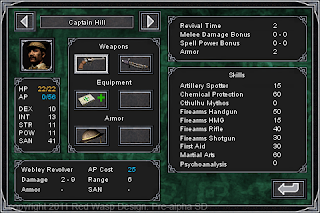Anyway, as much as Call
of Cthulhu: The Wasted Land employs the mechanics of Call
of Cthulhu, it is not a true RPG. Not in the sense of a pen
and paper RPG such as Call of Cthulhu, nor
in the sense of a computer RPG. Rather it is a skirmish combat game, one that is
Action Point driven and turn-based, much in the same mode as the classic
computer games, Laser Squad and X-Com. The game has the player control up to
six characters, and on each turn, the player will expend each character’s
Action Points to move that character and have him attack his opponents – with
an option for taking time to aim at his opponents – as well as to heal and even
psychoanalyse his allies!
The setting is the
Western Front in 1915. As related in his diaries, a British squad under Captain
Hill must defend against a German attack that grows stranger and stranger. Not
just ordinary German soldiers, but cult fanatics and zombies too! Fortunately,
Professor Brightmeer, a Miskatonic University scholar on attachment to British Military
Intelligence is on hand to inform Captain Hill and his men that a German
occultist has turned to more outré means to bring about victory for the Kaiser!
So begins the desperate search for the means to stop this dastardly villain,
which will take the squad out of the trenches and into No-Man’s Land, before
going underground over the course of eleven missions. Along the way they will
avoid things as ordinary as poison gas and barbed wire, and things as
otherworldly as spiders from Leng and giant walking tentacle plants.
Most of the eleven
missions involve holding off the Hun, either to defend a location or to get to
a location. This has the characters dodging from cover to cover, searching for
strongpoints where they can heal, researching documents, and more. For the most
part, the missions are very linear, often with one safe path through the
mission zone. Even when the characters have to enter patches of poison gas,
they can be equipped with gas masks.
In between missions,
characters are taken through two upgrade steps. The first sees their stats and
skills improved. It is here that the mechanics of Call of
Cthulhu are at their most obvious, though in a slimmed down
fashion that focuses on those numbers necessary for combat. Skills, rated on a
percentile skill, are arms and equipment, along with the First Aid Skill to
heal the sick and the Psychoanalysis Skill to heal the mentally disturbed.
Stats are rated on a 3 to 18 scale, and are improved to one of two ends. The
first is to increase the number of Action Points that a character has in
combat, whilst the second is to increase a character’s Sanity and thus his
ability to withstand mental shocks.
 |
| A Sample Character: Captain Hill |
The second upgrade
step deals with equipment. Here a character can upgrade from his trusty
Lee-Enfield rifle to a Hotchkiss M1914 heavy machine gun or a Winchester Model
1912 pump-action shotgun. There is a small armoury of weapons available, both
guns and melee weapons, as well as gasmasks, armour, and even homing pigeons which
will deliver requests for artillery support. Medical kits are also available as
are books derived from the works of Freud that will help restore a character’s
Sanity, whilst it is possible in later missions for characters to learn spells,
although casting these greatly deplete the Sanity of the caster.
The mechanics of Call
of Cthulhu also show within a mission. First in the use of
the skills, though you see no percentile dice being rolled, and second, in the Sanity
mechanic. Sanity is lost when attacking and being attacked by forces of the
Mythos, and when too much is lost, a character can be paralysed with fear, sent
catatonic, or even sent manic! The latter is incredibly taxing on the body, the
sufferer usually ending up dead, but whilst manic, a character becomes a force
of nature, able to charge the enemy and deal out damage aplenty.
 |
| The redoubtable Sid Brown alerts Captain Hill as to the imminent danger! |
Whilst game play is
simple, it is actually quite challenging in places, the final mission overly
so, and it might take a restart or two to really get into the game. It does not
help that game play is hampered by slightly clunky controls that sometimes will
have you stabbing a stubby finger at the screen of your tablet in frustration.
Another often annoying factor is that the missions tend to be very linear in
nature – “Go there!”, “Do that!”, “Now exit over there!” – such that there is
not a great deal of variety in terms of play. This is exacerbated by the fact
that a lot the spells do not become available until last quarter of the game,
limiting the option of creating variations upon the gun toting characters that dominate
game play.
Inspired by the
events of Lovecraft’s Herbert West: Reanimator, the game’s
treatment of the Mythos is more pulp than purist as it mixes a number of Mythos
entities together and its game play is all combat. Where The Wasted
Land shines is in its detail and its atmosphere. Although a little
anachronistic in places (easily portable machine guns in 1915?), all of the
characters are well defined, and the battlefields feel suitably ‘gone to hell,’
literally a wasted land. The animation is good too – there is something quite
unnerving to see a Dark Young lumbering towards your squad as they attempt to
blast it to bits before their sanity is blown too. Overall, Call of
Cthulhu: The Wasted Land is an engaging electronic treatment of
Lovecraftian horror worthy of your time and a sequel.

No comments:
Post a Comment